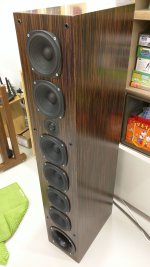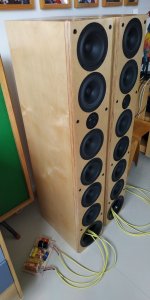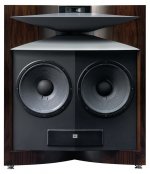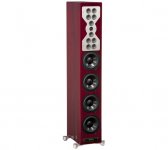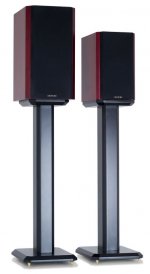I could drive these louder than needed in a 700sqft living room and a 2A3 SET
Yeah, with his new revelation, the obvious solution is to make a line array of Alpair 10s + super tweeter and power taper them to get the desired efficiency, but then a XO guru would need to work it out for kit apps.
Last edited:
Dunno. Klipsch. Zu Audio.
Seen a lot of measures of those. None had a decent impedance for a high Rout. Doesn’t mean there aren’t some. And note that Klipsch are often as much as 3dB optimistic on efficiency.
dave
"as much as 3dB" seems to be an overly kind number.
from Stereophile:
RP-600M: " The Klipsch's specified sensitivity is an extraordinarily high 96dB/2.83V/m. My estimate was much lower, at 89.6dB(B)/2.83V/m"
Forte III: "The Klipsch's specified sensitivity is an extraordinary 99dB/2.83V/m; my estimate was lower, at 95.2dB(B)/2.83V/m"
"anything from Klipsch" seems to be a common answer when people ask about speakers for tube amps and while 89.6 isn't terrible there are plenty of other brands of smallish speakers with similar numbers (that likely get skipped over because they didn't exaggerate).
The impedance of the two tested above look to be anything but smooth which seems unfriendly to SET tube amps.
from Stereophile:
RP-600M: " The Klipsch's specified sensitivity is an extraordinarily high 96dB/2.83V/m. My estimate was much lower, at 89.6dB(B)/2.83V/m"
Forte III: "The Klipsch's specified sensitivity is an extraordinary 99dB/2.83V/m; my estimate was lower, at 95.2dB(B)/2.83V/m"
"anything from Klipsch" seems to be a common answer when people ask about speakers for tube amps and while 89.6 isn't terrible there are plenty of other brands of smallish speakers with similar numbers (that likely get skipped over because they didn't exaggerate).
The impedance of the two tested above look to be anything but smooth which seems unfriendly to SET tube amps.
Last edited:
Dunno. Klipsch. Zu Audio. And a bunch of boutique manufacturers at least seem to market some pretty efficient speakers in a reasonable footprint. Some of them are pretty well regarded. Again. Seems pretty relative. I wasn’t asking about bookshelf speakers.
What P10 and @invaderzim said about Kilpsch!
Zu Omen Mk1 and Tekton Lore use the Pro Audio Eminence Legend B102 Eminence Legend B102 10" Bass Guitar Speaker 200W 8 Ohm
- one version of the Lore uses the Audax TW025A28 tweeter Audax TW025A28 1" Gold Dome Tweeter
Tekton Lores vs. ZU Omen MK I: Battle of the full range budget speakers. Only one can be KING! - YouTube
IMO, nothing to get excited about, I'll pass.
...one more, 7.5" driver 90dB 8Ω but could be good in a 2-way driven with 300B SET amp -
SATORI 7.5" MW19TX-8 TeXtreme Cone Woofer - 8 ohm
SATORI 7.5" MW19TX-8 TeXtreme Cone Woofer - 8 ohm
This was my pair of Uluwatu
Yeap, they were definitely easy to drive as only the Uluwatu & Altec 604 could rock out on the 2A3 SET.
Again, the bass is WORLDCLASS in terms of punch, depth, speed (no overhang) and ability to GO LOUD. I never heard drums so real reproduced ever.
What lacked was, despite 6 woofers per side, they aren't detailed. They cant be matched as a woofer modules to high end diy designs I had.
Sure you might say it was unfair i wanted them to match to Acoustic Elegance TD15M and JBL beryllium compression driver but the bass was THAT GOOD and in my scenario i had hoped it worked.
I tried the same design with higher end SB midwoofers, the SB15NRX but it didnt work as i planned.
Ive contacted someone to help design me something with Satori midwoofers in hopes to get the same magic but at a higher fidelity level.
Midrange? Voices? This is where they aren't as good as 3 ways. Being a 2.5 way the vocals are by 2 mids that also does bass. It could've been cleaner but pop/rock fans accept them as is. One could consider using the uluwatu midwoofers and cabinet only as a bass tower to match to any bookshelf speakers they want to get best of both worlds.
Imaging? SB Satori drivers' QC is unparalleled from what I was told by them. I've measured a pair of Rinjani entire speakers and found the impedance to be within 0.5% of each other. Whilst Uluwatu doesnt use satori drivers, imaging was rock solid despite a big tv between the speakers.
Having also build Troels' designs (Jenzen Seas ER TL) I can say dont do it if you live in a concrete apartment, i think his crossover tonal balance are for wooden houses. You could turn the 3rd way active and perk up the gain though, I did that for the Jenzen and it worked like a charm.
Yeap, they were definitely easy to drive as only the Uluwatu & Altec 604 could rock out on the 2A3 SET.
Again, the bass is WORLDCLASS in terms of punch, depth, speed (no overhang) and ability to GO LOUD. I never heard drums so real reproduced ever.
What lacked was, despite 6 woofers per side, they aren't detailed. They cant be matched as a woofer modules to high end diy designs I had.
Sure you might say it was unfair i wanted them to match to Acoustic Elegance TD15M and JBL beryllium compression driver but the bass was THAT GOOD and in my scenario i had hoped it worked.
I tried the same design with higher end SB midwoofers, the SB15NRX but it didnt work as i planned.
Ive contacted someone to help design me something with Satori midwoofers in hopes to get the same magic but at a higher fidelity level.
Midrange? Voices? This is where they aren't as good as 3 ways. Being a 2.5 way the vocals are by 2 mids that also does bass. It could've been cleaner but pop/rock fans accept them as is. One could consider using the uluwatu midwoofers and cabinet only as a bass tower to match to any bookshelf speakers they want to get best of both worlds.
Imaging? SB Satori drivers' QC is unparalleled from what I was told by them. I've measured a pair of Rinjani entire speakers and found the impedance to be within 0.5% of each other. Whilst Uluwatu doesnt use satori drivers, imaging was rock solid despite a big tv between the speakers.
Having also build Troels' designs (Jenzen Seas ER TL) I can say dont do it if you live in a concrete apartment, i think his crossover tonal balance are for wooden houses. You could turn the 3rd way active and perk up the gain though, I did that for the Jenzen and it worked like a charm.
Attachments
@kyngfish
We all come here to learn and share knowledge. The issue is that Physics is a B1tch sometimes. It often happens that people have the wrong expectations reading some of the manufacturer claims. Many speaker manufacturers compromise a lot to get the looks right and then straight out lie about specs, since this is what sells in the end.
You can have multiple drivers boost the efficiency, see Uluwatu, and this will also add Sd (Surface area of the cones) but will come at a higher cost and usually require lower cost drivers. The top high end speakers of a lot of manufacturers achieve good sensitivity by the multiple driver approach. Even Troels in the 861 does this using a2.5way, meaning the two bass drivers work together to boost efficiency and increas driver surface area.
Listen to the difference of bass from a 6" or a 10" driver or the equivalent in driver surface area. The issue with the multidriver approach is getting the integration of the drivers right. Not just the measurements on and off axis to make the whole a unit and then even more difficult to have the instruments sound exactly as they should and have the speaker disappear as if it isn't there,
I like Klipsch, currently have an old Cornwallis on loan, and here Klipsch went old school, which with a decent low end of course means big. The other "brass" Klipsch e,g. PR are not ideal for low power SET amps, efficiency, impedance spikes, etc... Still like the sound (disclaimer like horns😉) but does not compare to the herritage line of speakers, which are made for SETs.
The Zu, and this holds more or less true for all fullrange driver speakers you mentioned (disclaimer I personally do not like very much). Yes they are quite good for SETs, high impedance, but if you want to look at the measurements done by John Atkins at Stereophile, the king of measurements, for the Zu Soul Supreme:
Zu Audio Soul Supreme loudspeaker Measurements | Stereophile.com
You will see that the sensitivity is 91,5db instead of the 97 claimed and these are quite BIG speakers in your book, having a 10" driver. The Soul Supreme also uses a super tweeter but still they have some horrendous dips in the frequency spectrum that you can easily hear and bass drops of steep at 50hz
Don't get me wrong Zus can be fun at times and John Casey does some really good obscure music demos at shows and they bring out the midrange bloom of SET well but they are not very good at reproducing instruments as they really sound. If you just care about the emotion they might work for you.
Good luck
We all come here to learn and share knowledge. The issue is that Physics is a B1tch sometimes. It often happens that people have the wrong expectations reading some of the manufacturer claims. Many speaker manufacturers compromise a lot to get the looks right and then straight out lie about specs, since this is what sells in the end.
You can have multiple drivers boost the efficiency, see Uluwatu, and this will also add Sd (Surface area of the cones) but will come at a higher cost and usually require lower cost drivers. The top high end speakers of a lot of manufacturers achieve good sensitivity by the multiple driver approach. Even Troels in the 861 does this using a2.5way, meaning the two bass drivers work together to boost efficiency and increas driver surface area.
Listen to the difference of bass from a 6" or a 10" driver or the equivalent in driver surface area. The issue with the multidriver approach is getting the integration of the drivers right. Not just the measurements on and off axis to make the whole a unit and then even more difficult to have the instruments sound exactly as they should and have the speaker disappear as if it isn't there,
I like Klipsch, currently have an old Cornwallis on loan, and here Klipsch went old school, which with a decent low end of course means big. The other "brass" Klipsch e,g. PR are not ideal for low power SET amps, efficiency, impedance spikes, etc... Still like the sound (disclaimer like horns😉) but does not compare to the herritage line of speakers, which are made for SETs.
The Zu, and this holds more or less true for all fullrange driver speakers you mentioned (disclaimer I personally do not like very much). Yes they are quite good for SETs, high impedance, but if you want to look at the measurements done by John Atkins at Stereophile, the king of measurements, for the Zu Soul Supreme:
Zu Audio Soul Supreme loudspeaker Measurements | Stereophile.com
You will see that the sensitivity is 91,5db instead of the 97 claimed and these are quite BIG speakers in your book, having a 10" driver. The Soul Supreme also uses a super tweeter but still they have some horrendous dips in the frequency spectrum that you can easily hear and bass drops of steep at 50hz
Don't get me wrong Zus can be fun at times and John Casey does some really good obscure music demos at shows and they bring out the midrange bloom of SET well but they are not very good at reproducing instruments as they really sound. If you just care about the emotion they might work for you.
Good luck
Last edited by a moderator:
The methods and parts vary between the types of speaker where directivity might/might not be used that way.Why is this even relevant.
...........but they are not very good at reproducing instruments as they really sound. If you just care about the emotion they might work for you.
..............
Ultimately, that is the only thing that matters in a good design. It is the goal to achieve, the Holy Grail in audio.
The only Troels design I heard is the mine, DTQWTII, does it wonderfully. But reading the comments of the builders of the other models, it seems that it is a constant in his designs. For something to his productions he evaluates them by listening to music, and as he always says, the measurements do not say everything.
The tone, the timbral, that's what I enjoyed last night listening to Thelonius Monk
Last edited:
Listen to the difference of bass from a 6" or a 10" driver or the equivalent in driver surface area.
Sd is not all you want to look for. The swept volume (Sd x xmax) is the measure of how much air can be moved.
The issue with the multidriver approach is getting the integration of the drivers right.
Any multi-driver box, whether multiple woofers or even speakers. Anytime the physical distance of the drivers is not less than the quarter-wavelength of the XO frequency, one has made a compromise.
If the woofers are close enuff together (ie that quarter-wavelength again), they work together as one.
...then even more difficult to have the instruments sound exactly as they should and have the speaker disappear as if it isn't there...
FR is a measure of a flattness at the surface. Reproducing the small details closer to the bottom is very important for being able to distinguish details of voices and instruments as well as it takes the small detail to be able to throw a solid 3D image/soundstage. Having the box disappear often has a lot to do with the boxes diffraction signature. This for instance is the reason for 3 main varieties of miniOnkens, the hard to build ones having the lowest diffraction signature and the box being able to disappear more easily. It is also important that the box itself not be a source of radiation. This haapens a lot with many speaker boxes not well designed or executed.
dave
" S d no es todo lo que quieres buscar. El volumen barrido (S d xx max ) es la medida de la cantidad de aire que se puede mover. "
I prefer a higher SD and lower Xmax and not the other way around.
The distortion will be less.
Actually, I think that this whole issue of tall towers with a large number of conductors, bring more problems than advantages, except for the problem of the space it occupies. Mc Intosh adopted the system and I heard one of those boxes in a sales room. Immediately afterwards he asked to audition the JBL Everest DD66000.
Everest offered an amazing spatiality, I looked at the VU needle of the coupled amplifier and the peaks reached 1 watt. The MC Intosh speaker needed to go up 6 dB more for the same SPL.
In addition, he cannot understand those who spend a lot of money on famous speakers of small size, located on pedestals. A column with the same imaginary "virtual" volume, "from head to toe" would occupy the same space and would give much better sound in mids and bass.
I think that the famous WAF and not so much the space, is the main drawback, that "huge and grotesque" thing looks "artistic" if we shrink it and put it on a pedestal. Clearly, as others have mentioned, they are unaware of Hoffman's "Iron Law." And many do not want to argue explaining to them, it seems that the times of "Lorenzo and Pepita" have not changed ........
I prefer a higher SD and lower Xmax and not the other way around.
The distortion will be less.
Actually, I think that this whole issue of tall towers with a large number of conductors, bring more problems than advantages, except for the problem of the space it occupies. Mc Intosh adopted the system and I heard one of those boxes in a sales room. Immediately afterwards he asked to audition the JBL Everest DD66000.
Everest offered an amazing spatiality, I looked at the VU needle of the coupled amplifier and the peaks reached 1 watt. The MC Intosh speaker needed to go up 6 dB more for the same SPL.
In addition, he cannot understand those who spend a lot of money on famous speakers of small size, located on pedestals. A column with the same imaginary "virtual" volume, "from head to toe" would occupy the same space and would give much better sound in mids and bass.
I think that the famous WAF and not so much the space, is the main drawback, that "huge and grotesque" thing looks "artistic" if we shrink it and put it on a pedestal. Clearly, as others have mentioned, they are unaware of Hoffman's "Iron Law." And many do not want to argue explaining to them, it seems that the times of "Lorenzo and Pepita" have not changed ........
Attachments
The distortion will be less.
A generalization that often falls apart in the field.
Everything you do when designing a loudspeaker is a compromise.
Dave
@dave
agree with everything you said. Forgot about the driver seperation rules. Everything is a compromise in audio and knowing what you can live with and what you want is the key.
There was a audiophile rule of thumb ideally keeping cone movement bellow 10% of Xmax to stay below the noise floor (<1% THD) of the driver. But that depends on the driver and audio chain. The most extreme audiophiles I knew had this as a rule and probably why compression drivers are so good IMO😉
Cheers
agree with everything you said. Forgot about the driver seperation rules. Everything is a compromise in audio and knowing what you can live with and what you want is the key.
There was a audiophile rule of thumb ideally keeping cone movement bellow 10% of Xmax to stay below the noise floor (<1% THD) of the driver. But that depends on the driver and audio chain. The most extreme audiophiles I knew had this as a rule and probably why compression drivers are so good IMO😉
Cheers
A generalization that often falls apart in the field.
Everything you do when designing a loudspeaker is a compromise.
Dave
You're right, you don't have to generalize.
From what I transcribe this part, which coincides with my way of seeing the problem, although I am not an expert on the subject, just a little reading from various sources.
" Woofers with lower Xmax sound better
I've heard a lot of speakers in my day. Probably around 200 or so, including all types, such as 3 piece subwoofer-satellite systems, tower multiway speakers, and of course many small 2-ways. One thing I have noticed is that I generally prefer the sound of woofers with lower Xmax, provided the woofer is not being overdriven. In this discussion, I'm not referring to minor millimeter differences in midwoofers, but large Xmax differences in larger woofers.
I never gave it much thought as to why. What I did notice though is that this statement stirs up a few folks who would like to think that their super-ultra-Xmax woofers are the best sounding woofers available. This is the 2"+ peak to peak crowd who determines a subwoofer value by a dollar to displacement ratio. Bragging rights are important to some people, and when you get the right to brag about having the highest output, you definitely cannot brag about having the highest quality sound.
Lower Xmax woofers, as a generalization, sound better. It's the result of a simple design philosophy. While increasing a woofer design's Xmax, at some point the woofer stops being a reproducer of music, and starts being a power tool of noise making. These "power tools" are more suitable for home theater where the typical sound being reproduced is noise anyway. But for music, forget it.
I can summarize most of the issues:
Long voice coils have associated response problems. Look at any monster woofer's response in the lower midrange and you will surely see a massive peak and dip. Short voice coil woofers don't have this problem. With some woofers, the initial peak is still audible even with a low 4th order rolloff. In fact, peaks are still audible even if completely filtered out - They re-appear lower in frequency as 3rd order harmonic distortion. This is why some subs are easily localized even when crossed over at 80 hz.
Large excursion woofers are typically designed to work with high power in smallish enclosures, making the stroke very non-linear at the extremes of operation due to extreme pressures. That results in distortion.
Long voice coils have very high Le. Some begin rolling off at 80hz already.
Long voice coils have Le distortion - inductance changes greatly based on the coil's location in the gap.
Large excursion woofers often have more mechanical operating noise - slapping voice coil leads, and air noise from high pressure escaping from the pole piece vent.
Large excursion woofers are required to have huge surrounds to support their excursion. Often these are poorly designed and suck-back or deform under heavy load, causing distortion. Or on the other side of this argument, to avoid deformation, the surrounds are made so thick and stiff that the Fs of the driver goes way up.
Related to the issue above, large excursion woofers often have poor bass extension and require active EQ to get a reasonable bass response.
This is not related to sound quality, but is still very important: The large magnets required to move these large masses of voice coil and cone are occasionally so large that they can't be placed within 10 feet of a TV. Specifically, keep those damn magnets away from my expensive ISF'd RPTV.
A good woofer design can minimize many of the problems listed above, but there's a point of diminishing returns. And here's the core statement of this article: The more output a woofer has, the more tradeoffs it has to make in it's design. There are a few workarounds that help the situation, such as underhung motors like the ones used in Aurasound's subs, or the dual gap/short coil design used in Adire's XBL^2 subs. These help greatly, but many core design tradeoffs remain.
My advice to all in factoring Xmax of a woofer into a purchase decision is to pick the woofer with the lowest Xmax that can sustain your preferred music listening level. If you can't reach that level with one woofer of reasonable Xmax, use two or more. If you have space limitations and listen only to home theater at outrageous levels, then by all means sort your possibilities by displacement per dollar and get the most Xmax you can."
By the way, the link ( post two) doesn't work, but it would appear that the above belongs to Zaph audio.
Lower Xmax sounds better ? Opinions please ... maybe Npdang will chime in too 🙂 | DiyMobileAudio.com Car Stereo Forum
The old audiophile rule came from a time when woofers where very different beasts. Modern computer design tools and the quest for ever smaller boxes have made for great progress.
I know they are out there, i would like to hear some.
dave
and probably why compression drivers are so good
I know they are out there, i would like to hear some.
dave
@planet10
You haven't heard compression drivers? Or am I being daft or are you saying you don't think compression drivers are low distortion?
The TAD2001 or now the Vitavox S2 AlNiCo used by Living Voice, Silbatone WE, JBLs, but even the affordable 18 SOUND NSD1095N are spectacular.
I might try a project for my GF's nephew (Asathor DIY speaker here on the forum) that uses a Tymphany DFM-2535R00-08 at 80€ a piece and a Celestion H1 9040P horn for 15€. I'll give you a feedback on how they sound if we end up building it.
Regarding the distortion rule. Of course look up the Xmax where you remain below 1% and use that with Sd to determine what you need. Some drivers will go close to XMax and have less than noise floor many others won't, especially paper membranes (which I tend to often prefer) will usually not stay low distortion close to Xmax in my experience.
Xmax is always thrown around but 10% distortion is kind of useless, much more interesting for audiophiles would be the 1%/Noise Floor or maybe 3% noise levels to determine what driver would be suitable, but not many manufacturers deliver the Kippel data easily.
I can also agree with academia50 that generally lower XMax woofers tend to sound better in my ears. I have come to be a bigger lighter membrane (actually MMS) higher efficiency sounds best. Of course there are exceptions, especially if you are willing to spend the cash
Cheers
You haven't heard compression drivers? Or am I being daft or are you saying you don't think compression drivers are low distortion?
The TAD2001 or now the Vitavox S2 AlNiCo used by Living Voice, Silbatone WE, JBLs, but even the affordable 18 SOUND NSD1095N are spectacular.
I might try a project for my GF's nephew (Asathor DIY speaker here on the forum) that uses a Tymphany DFM-2535R00-08 at 80€ a piece and a Celestion H1 9040P horn for 15€. I'll give you a feedback on how they sound if we end up building it.
Regarding the distortion rule. Of course look up the Xmax where you remain below 1% and use that with Sd to determine what you need. Some drivers will go close to XMax and have less than noise floor many others won't, especially paper membranes (which I tend to often prefer) will usually not stay low distortion close to Xmax in my experience.
Xmax is always thrown around but 10% distortion is kind of useless, much more interesting for audiophiles would be the 1%/Noise Floor or maybe 3% noise levels to determine what driver would be suitable, but not many manufacturers deliver the Kippel data easily.
I can also agree with academia50 that generally lower XMax woofers tend to sound better in my ears. I have come to be a bigger lighter membrane (actually MMS) higher efficiency sounds best. Of course there are exceptions, especially if you are willing to spend the cash
Cheers
Last edited:
@fishball79
Well in Denmark, there are few wooden houses, but it does seem like he has wooden floors. I had to do some installs in brick lofts with concrete floors and that was always a challenge. Did you rest the speakers directly on the floors as in your pictures? I have never installed a Troels speaker in that environment so cannot comment on that, but one person had a 3WC, cannot remember which one with tile floors and adding carpets, some bookshelves and plants helped. Very reflective rooms is where DSP really helps, although I am still not a big fan of DSP for bass its most often the way to go.
Well in Denmark, there are few wooden houses, but it does seem like he has wooden floors. I had to do some installs in brick lofts with concrete floors and that was always a challenge. Did you rest the speakers directly on the floors as in your pictures? I have never installed a Troels speaker in that environment so cannot comment on that, but one person had a 3WC, cannot remember which one with tile floors and adding carpets, some bookshelves and plants helped. Very reflective rooms is where DSP really helps, although I am still not a big fan of DSP for bass its most often the way to go.
@jderimig
I have not heard the 3WC 15 but talked to two people extensively that had it, there is also a video of someone who built one on youtube. The only complaint was that vertical soundstage could have been better. I have listened to two DTQWT. One with SET and one with PP.
The best thing about the DTQWT is the bass and midrange, tweeter could be a bit better, but it really is exceptional with tubes, expecially if you like a bit more coloration. The one with the SET had the 2x10 (6ohm) with around 8-16 Watts 300B the other one was 50W pp EL34 with the 12" ( 4ohm) which benefited the bass. Power is good in bass. Very engaging speakers and more of a horn and old school sound than the 861. They have a decent amount of membrane mass to throw around so looking at the site Troels recommends 8 W. You could feel the grip of the 50W, but that 300B midrange, depends on what you like. There is a reason the DTQWT made Troels famous. The 861 is more classical not BL horn. The benefit of the 3wc15 is membrane area obviously have a listen they sound pretty good online with mediocre integrated and bad placement.
The 861 is smooth throughout. Only you can decide
I am a fan of 15" membranes so I am partial but 6watts will be tricky for really good bass. The DTQWT was exceptional, probably due to the design in going very low with low wattage. You need to see what impedence your amp can deal with. Also just write Troels who will help even if he is super busy. Expect short answers.
Hope that helps.
I have not heard the 3WC 15 but talked to two people extensively that had it, there is also a video of someone who built one on youtube. The only complaint was that vertical soundstage could have been better. I have listened to two DTQWT. One with SET and one with PP.
The best thing about the DTQWT is the bass and midrange, tweeter could be a bit better, but it really is exceptional with tubes, expecially if you like a bit more coloration. The one with the SET had the 2x10 (6ohm) with around 8-16 Watts 300B the other one was 50W pp EL34 with the 12" ( 4ohm) which benefited the bass. Power is good in bass. Very engaging speakers and more of a horn and old school sound than the 861. They have a decent amount of membrane mass to throw around so looking at the site Troels recommends 8 W. You could feel the grip of the 50W, but that 300B midrange, depends on what you like. There is a reason the DTQWT made Troels famous. The 861 is more classical not BL horn. The benefit of the 3wc15 is membrane area obviously have a listen they sound pretty good online with mediocre integrated and bad placement.
The 861 is smooth throughout. Only you can decide
I am a fan of 15" membranes so I am partial but 6watts will be tricky for really good bass. The DTQWT was exceptional, probably due to the design in going very low with low wattage. You need to see what impedence your amp can deal with. Also just write Troels who will help even if he is super busy. Expect short answers.
Hope that helps.
@tubeglow49, thanks for the information.
The more I analyze I am rethinking my requirements. I am not wed to my amp, its my own build and I can spin another build with more power at less investment than good speakers. So now I am thinking of building a class A PP version of my amp that can deliver 12 to 25 watts and that will open up more economical options. The DTQWT sounds like a good choice but the investment without the opportunity of an audition gives some pause. There still would be pause with lower cost options but less pause.
The more I analyze I am rethinking my requirements. I am not wed to my amp, its my own build and I can spin another build with more power at less investment than good speakers. So now I am thinking of building a class A PP version of my amp that can deliver 12 to 25 watts and that will open up more economical options. The DTQWT sounds like a good choice but the investment without the opportunity of an audition gives some pause. There still would be pause with lower cost options but less pause.
- Home
- Loudspeakers
- Multi-Way
- DIY Multi-Way for 300B SET
